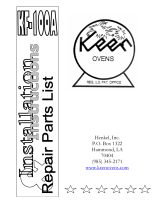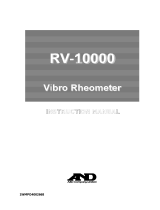Page is loading ...

Technical Data Sheet
LOCTITE
®
3609™
March-2008
PRODUCT DESCRIPTION
LOCTITE
®
3609™ provides the following product
characteristics:
Technology Epoxy
Chemical Type Epoxy
Appearance (uncured) Dark, red viscous gel
LMS
Components One component - requires no mixing
Cure Heat cure
Application Surface mount adhesive
Key Substrates SMD components to PCB
Other Application Areas Small parts bonding
Dispense Method Syringe
Dispense Speed Medium 15,000 -25,000 dots/h
Wet Strength High
LOCTITE
®
3609™ is designed for the bonding of surface
mounted devices to printed circuit boards prior to wave
soldering. Particularly suited for applications where medium to
high dispense speeds, high dot profile, high wet strength and
good electrical characteristics are required. LOCTITE
®
3609™
has been used successfully in lead free processes with water
and alcohol based fluxes under conditions outlined in the
Environmental Resistance section.
TYPICAL PROPERTIES OF UNCURED MATERIAL
Specific Gravity @ 25 °C 1.2
Particle Size, µm <150
Flash Point - See MSDS
Yield Point, 25 °C, Pa
Cone & Plate Rheometer:
Haake PK 100, M10/PK 1 2° Cone
250 to 700
LMS
Casson Viscosity @ 25 °C, Pa∙s
Cone & Plate Rheometer:
Haake PK 100, M10/PK 1 2° Cone
0.16 to 2.0
VISCOSITY VS. TEMPERATURE
The following graph shows a typical temperature-viscosity
curve as measured using a Haake rotoviscometer PK100,
M10/PK1 2° Cone system at a shear rate of 2 s
-1
which is
representative of the shear rate in the dispense nozzle.
Increased cabin or nozzle temperature in the 30°C to 35°C
range may aid dispense performance at higher dispense
speeds.
Viscosity, Pa∙s
Temperature, °C
400
300
200
100
0
20 25 30 35
TYPICAL CURING PERFORMANCE
Recommended conditions for curing are exposure to heat
above 100 °C (typically 90-120 seconds @ 150 °C). Rate of
cure and final strength will depend on the residence time at the
cure temperature.
Cure Speed vs. Time, Temperature
The following graph shows the rate of torque strength
developed with time at different temperatures. These times are
defined from the moment the adhesive reaches cure
temperature. In practice, total oven time may be longer to allow
for heat up period. Strength is measured on 1206 capacitors @
22 °C, tested according to IPC SM817, TM-650 Method 2.4.42.
% of Full Strength
Time at Temperature, minutes
100
75
50
25
0
0 1 2 3 4 5 6 7 8 9 10
150°C
125°C
100°C
TYPICAL PROPERTIES OF CURED MATERIAL
Cured for 30 minutes @ 150 °C
Physical Properties:
Coefficient of Thermal Expansion,
ISO 11359-2, K
-1
145×10
-6
Coefficient of Thermal Conductivity, ISO 8302,
W/(m·K)
0.4
Glass Transition Temperature, ASTM D 4065, °C 73
Specific Heat, kJ/(kg·K) 0.3
Density, BS 5350-B1 @ 25 °C, g/cm³ 1.4

TDS LOCTITE
®
3609™, March-2008
Electrical Properties:
Surface Resistivity, IEC 60093, Ω 2×10
15
Volume Resistivity, IEC 60093, Ω·cm 2×10
15
Surface Insulation Resistance, Ω:
SN 59651:
Initial 0.1×10
9
Aged for 4 days @ 40 °C, 93 % RH 10×10
9
Aged for 21 days @ 40 °C, 93 % RH 1×10
9
Electrolytic Corrosion, DIN 53489 AN-1.2
Dielectric Constant / Dissipation Factor, IEC 60250:
1-kHz 3.7 / 0.009
10-kHz 3.3 / 0.03
1,000-kHz 3.2 / 0.03
10,000-kHz 3.1 / 0.03
TYPICAL PERFORMANCE OF CURED MATERIAL
Adhesive Properties
Cured for 10 minutes @ 110 °C
Push-off Strength:
C-1206 on bare FR4 board N ≥20
LMS
(lb) (≥4.5)
Cured for 5 minutes @ 125 °C
Pull-off Strength, Siemens norm SN59651:
C-1206 on bare FR4 board N 40 to 80
(lb) (9 to 18)
Torque Strength, IPC SM817 , TM-650 Method 2.4.42:
C-1206 on bare FR4 board N·mm 30 to 70
(in.oz) (4 to 10)
Cured for 30 minutes @ 150 °C
Lap Shear Strength, ISO 4587:
Steel (grit blasted) N/mm² ≥10
LMS
(psi) (≥1,450)
Bond strength achieved in practice will vary considerably
depending on the SMD component type, adhesive dot size
and the type, grade and degree of cure of the solder
mask/resist.
TYPICAL ENVIRONMENTAL RESISTANCE
Cured for 30 minutes @ 150 °C
Lap Shear Strength, ISO 4587:
Mild steel (grit blasted)
Hot Strength
Tested at temperature
% Initial Strength at 22 °C
Temperature, °C
100
75
50
25
0
0 25 50 75 100 125 150 175
Chemical/Solvent Resistance
Aged under conditions indicated and tested @ 22 °C.
% of initial strength
Environment °C 100 h 500 h 1000 h
Air 22 100 100 95
Air 150 85 70 70
Heat/humidity 98% RH 40 110 110 100
Resistance to Hot Solder Dip
Cured for 90 seconds @ 150 °C
Hot Solder Dip, IPC SM817, TM-650 Method 2.4.42.1, Pass/Fail:
R-1206 on bare FR4 board:
Supported 60 seconds above solder
bath @ 260°C and dipped for 10
seconds
Pass
Resistance to Process Conditions
Cured for 90 seconds @ 150 °C
Torque Strength, IPC SM817 , TM-650 Method 2.4.42, % of initial
strength retained:
C-1206 on bare FR4 board:
Aged 30 seconds preheat to 100°C
and 3 seconds @ 260°C with flux and
wave solder
100
Resistance to Lead Free Solder
LOCTITE
®
3609™ can be used in lead free wave solder with
both water based and alcohol based fluxes
Lead Free Solder Test Conditions
Flux Types Multicore MF200 (alcohol based) and
Multicore MF300 (water based)
Wave Condition 100°C pre-heat with dual wave at 260°C
Components C1608 bonded with twin dot 0.8mm
SOD 80 bonded with single dot 1.1mm
Result No component loss in the wave
GENERAL INFORMATION
For safe handling information on this product, consult the
Material Safety Data Sheet (MSDS).
Directions for use
1.
LOCTITE
®
3609™ is supplied de-aerated in a range of
ready-to-use syringes which fit straight into a variety of air
pressure/time dispensing systems commonly available.
2. After storage in a refrigerator the adhesive must be
allowed to equilibrate to room temperature before use,
typically 2 to 4 hours.
3. Avoid cross contamination with other adhesive residues
by ensuring dispense nozzels, adapters etc. are
thoroughly cleaned.
4. Do not leave dirty nozzles on dispensing equipment while
not in use or soaking in solvents for long periods of time.
5. The quantity of adhesive dispensed will depend on the
dispense pressure, time, nozzle size and temperature.
6. These parameters will vary depending on the type of
dispensing system used and should be optimised
accordingly.
7. Dispensing temperature should ideally be controlled at a
value between 30 °C to 35 °C for optimum results,
however higher dispense temperatures are possible.
8.
LOCTITE
®
3609™ can also be dispensed using positive
displacement pump systems.
9. The product is not recommended for dispensing by pin
Henkel Americas
+949.789.2500
Henkel Europe
+44.1442.278.000
Henkel Asia Pacific
+86.21.2891.8000
For the most direct access to local sales and technical support visit: www.henkel.com/electronics

TDS LOCTITE
®
3609™, March-2008
transfer.
10.
Uncured adhesive can be cleaned from the board with
isopropanol, MEK or ester blends such as LOCTITE
®
7360™.
Loctite Material Specification
LMS
LMS dated February-04, 2004. Test reports for each batch are
available for the indicated properties. LMS test reports include
selected QC test parameters considered appropriate to
specifications for customer use. Additionally, comprehensive
controls are in place to assure product quality and
consistency. Special customer specification requirements may
be coordinated through Henkel Quality.
Storage
Store product in the unopened container in a dry location.
Storage information may be indicated on the product container
labeling.
Optimal Storage: 2 °C to 8 °C. Storage below 2 °C or
greater than 8 °C can adversely affect product properties.
Material removed from containers may be contaminated during
use. Do not return product to the original container. Henkel
Corporation cannot assume responsibility for product which
has been contaminated or stored under conditions other than
those previously indicated. If additional information is required,
please contact your local Technical Service Center or
Customer Service Representative.
Conversions
(°C x 1.8) + 32 = °F
kV/mm x 25.4 = V/mil
mm / 25.4 = inches
µm / 25.4 = mil
N x 0.225 = lb
N/mm x 5.71 = lb/in
N/mm² x 145 = psi
MPa x 145 = psi
N·m x 8.851 = lb·in
N·m x 0.738 = lb·ft
N·mm x 0.142 = oz·in
mPa·s = cP
Note
The data contained herein are furnished for information only
and are believed to be reliable. We cannot assume
responsibility for the results obtained by others over whose
methods we have no control. It is the user's responsibility to
determine suitability for the user's purpose of any production
methods mentioned herein and to adopt such precautions as
may be advisable for the protection of property and of persons
against any hazards that may be involved in the handling and
use thereof. In light of the foregoing, Henkel Corporation
specifically disclaims all warranties expressed or implied,
including warranties of merchantability or fitness for a
particular purpose, arising from sale or use of Henkel
Corporation’s products. Henkel Corporation specifically
disclaims any liability for consequential or incidental
damages of any kind, including lost profits. The discussion
herein of various processes or compositions is not to be
interpreted as representation that they are free from
domination of patents owned by others or as a license under
any Henkel Corporation patents that may cover such
processes or compositions. We recommend that each
prospective user test his proposed application before repetitive
use, using this data as a guide. This product may be covered
by one or more United States or foreign patents or patent
applications.
Trademark usage
Except as otherwise noted, all trademarks in this document
are trademarks of Henkel Corporation in the U.S. and
elsewhere.
®
denotes a trademark registered in the U.S.
Patent and Trademark Office.
Reference 1.2
Henkel Americas
+949.789.2500
Henkel Europe
+44.1442.278.000
Henkel Asia Pacific
+86.21.2891.8000
For the most direct access to local sales and technical support visit: www.henkel.com/electronics
/


